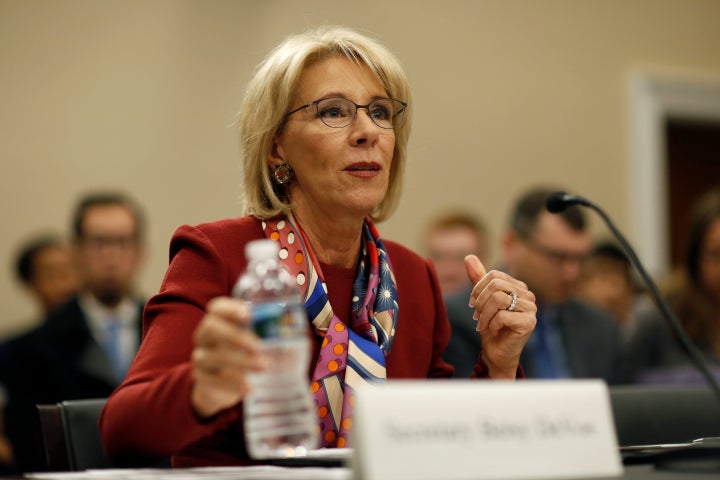
A nonpartisan government watchdog agency released a report Wednesday outlining severe disparities between how white students and students of color are disciplined ― the same day Education Secretary Betsy DeVos met with groups to discuss possibly rescinding Obama-era guidance designed to reduce these inequities.
The Government Accountability Office report, which was requested by Reps. Bobby Scott (D-Va.) and Jerrold Nadler (D-N.Y.), comes as civil rights leaders are fighting tooth and nail to save this guidance. The 2014 guidance calls on schools to reduce their reliance on harsh disciplinary practices like suspensions and expulsions. It also warns schools they could run afoul of federal law if certain groups of students are disproportionately punished.
The Education Department data analyzed in this report is from the 2013-2014 school year, and reveals deep discipline disparities across student groups ― the very problem the guidance is intended to address. Independent of school poverty level, type of public school or type of disciplinary action, boys, students with disabilities, and black students are being punished at far higher rates than other students. For black students, these inequities start as early as preschool.
This is the first such analysis to explicitly compare schools at different poverty levels. In high-poverty schools, black students are overrepresented among students who receive suspensions by 25 percentage points, and in more affluent schools, they are overrepresented by 12 points, the data shows. Students with disabilities face similar problems. In affluent schools, students with disabilities are overrepresented among students who receive suspensions by 20 points, while in low-income schools, they are overrepresented by nearly 11 points.
Notably, some disability groups claim they were left out of Wednesday’s discussions with DeVos on the disciplinary guidance. Two advocacy groups told HuffPost they asked for an invitation to the summit but were either rebuffed or ignored. Spokespeople for the Education Department did not respond to HuffPost’s request for comment on the matter.
Even though black students only make up about 16 percent of public school students, they account for nearly 40 percent of students who are suspended from school, the report says. A similar pattern exists for students with disabilities, and for male students in general. Students with disabilities make up about 12 percent of public school students, but account for a quarter of those who are suspended, referred to outside law enforcement or arrested at school.
“The analysis shows that students of color suffer harsher discipline for lesser offenses than their white peers and that racial bias is a driver of discipline disparities,” Scott said in a statement. “This report underscores the need to combat these gross disparities by strengthening, not rescinding, the 2014 Discipline Guidance Package, which recommends specific strategies to reduce the disparities without jeopardizing school safety.”
Proponents of the Obama-era guidance say that having the federal government voice its priorities in this area is an important step in keeping students safe. Indeed, harsh school discipline can have far-reaching effects on a student’s life. Students who face suspensions are more likely to drop out of school or eventually enter the criminal justice system. Advocates say the guidance is designed to help stymie this cycle.
But critics say the pressure to reduce reliance on suspensions has meant keeping disruptive or dangerous students in the classroom, thereby posing a threat to other students and staff members.
One critic of the guidance, a mother who met with DeVos on Wednesday, previously told HuffPost she has watched her children’s school district become more relaxed in discipline.
“Whatever intentions were set forth in the guidance, the response to the guidance has been kind of knee-jerk in nature that has ended up hurting all of the children,” said Nicole Landers of Baltimore County when asked about her general feelings on the guidance. “It takes away the rights from the victimized students, as the offending students are left in the classroom to avoid suspensions.”
However, the GAO report shows that national suspension rates had already begun to fall before the guidance was implemented.
The Education Department has said there is no specific timeline for when a decision will be made on whether to keep the guidance. The department did not respond to a request for comment on the guidance.
